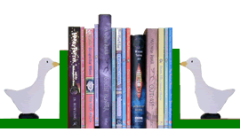Your author website will be much more effective if you avoid these mistakes.
1: Making it hard for visitors to find their way around the site
If you don’t provide a clear way for visitors to get around your site, they won’t find many of your pages. What you need is a clear navigation on each page that lists the main links along the top of the page or down the left hand side where people expect to see them. To work well, they need to be in the same order in the same place on every page to avoid confusing your visitors or leaving them stranded.
2: Using confusing navigation links
Although you might enjoy thinking up imaginative names for your navigation links, you risk confusing your visitors. They might not realise that “Shelf Space“ is your Books section, “Inside Secrets” means “About Me” and “Out and About” contains information on your speaking events. The situation gets even worse if you decide to use pictures instead of words. Remember that the visitors to your site are just one click away from going elsewhere, and that’s what they will do if you ask them to play a guessing game in order to find their way around.
3 Not providing a way to buy your books
There is no point in putting time and effort into promoting your books on your website if you don’t give visitors a chance to buy them. Unless you are selling books directly from your website, the simplest way to do this for print books is with a link to Amazon or another internet bookshop that stocks your book. Investigate whether the site has an associate scheme that pays income on sales as that can bring in some welcome income. For ebooks, you can link to link to the Kindle edition on Amazon and the epub edition elsewhere.
We always link to Amazon as our first choice as this allows potential customers to see reviews, sales rank and other information. Many of your potential customers will already have an Amazon account so they will be more likely to buy from them than from a shop they’ve never used before.
4: Leaving out-of-date information on your site
Statements like “to be published in 2011” or “I will be speaking at the 2012 Cheltenham Literary Festival” make your site look out-of-date and give the impression that you don’t care. If you put this type of information on your site, make a note in your diary of when you need to change it or get into the habit of checking your content once a month to pick up this type of issue. If you don’t want to spend that much time on your site or you have to pay a web designer to make changes, try to avoid putting dates in your content unless it’s absolutely essential. For forthcoming books, you can write “publication date – Sept 2014” which will still work after the book comes out.
5: Making grandiose claims that you can’t substantiate
Claiming that your book is the next Harry Potter or you are the next John Grisham sounds unconvincing when it comes from your own mouth (or keyboard) and puts everything else you’ve said on your website in doubt. That’s the sort of comparison best left to reviewers.
6: Having a hit counter on your site
Hit counters look amateur and don’t serve a useful purpose – do you really want to tell someone they are only the tenth person to visit a page? Although site statistics can be useful (and addictive), use a system that your visitors can’t see.
7: Using colours that make reading difficult
Reading on screen is tiring so don’t choose a colour scheme that makes it even harder. It’s best to have plenty of contrast between the letters and the background. Black on white is an obvious choice, but dark grey on white can look softer. Always avoid red on green and the opposite as this combination is difficult for most people and dreadful for anyone who is colour blind.
8: Putting up text as pictures
Getting a web page to look just the way you want can be frustrating and time consuming so it’s tempting to get the layout you want by creating it as a picture. But that is a really bad idea because it takes away people’s ability to adjust the size of the text to make it readable. It also makes the text completely invisible to search engines so it lessens your chances of the site showing up high in searches.
The same problem applies with Flash which also has the added complication that visitors can’t see it unless they have the right softwork installed. (Thanks to Paul Draker for reminding me about this.)
9: Using huge picture files
High resolution pictures have huge files that take a long time to download and slow your site down. Changing to lower resolution pictures will speed your site up considerably without any loss in quality showing up on screen.
10: Splitting articles between pages for no reason
A web page can be as long as you like so there is no problem with putting up a long article. Provided it’s interesting enough, people will scroll down to read it so there is no point in splitting an article in two just because the page is getting a bit long. If you do that, you just risk alienating readers who may not bother to finish the article because they don’t want to do another click. (This is quite different from providing a series of articles on related topics which it’s sensible to put on different pages.)
Diana Kimpton
If you found this article helpful, you may enjoy these other articles about author websites:
- Author websites – the basics
- Planning your author website
- Search engine optimisation – is it worth paying for?
- How to build traffic to your author website
.

Comments are closed.